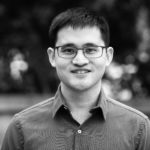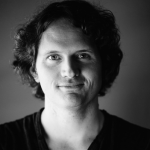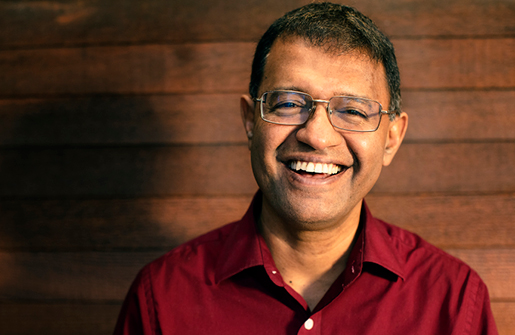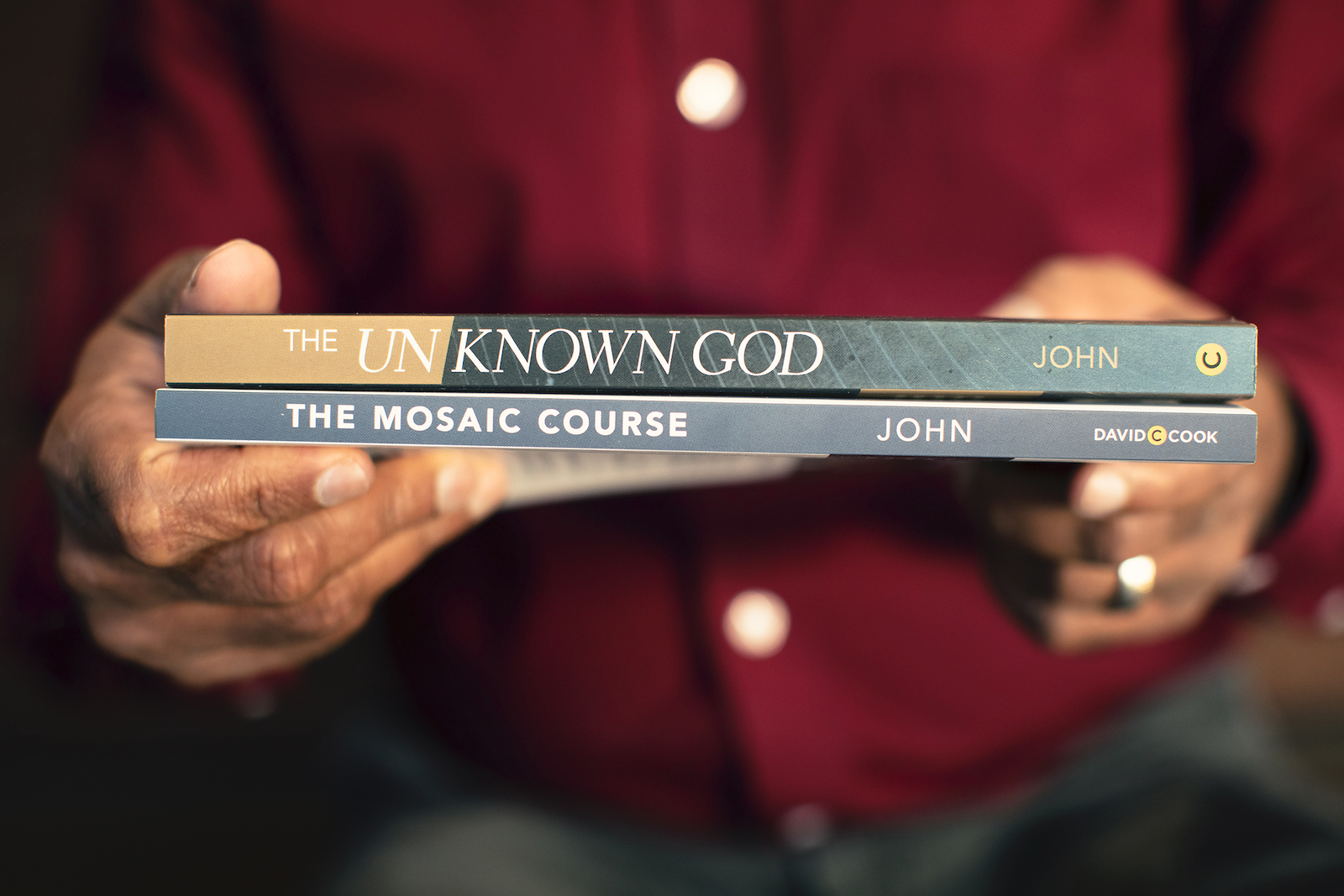
Mathew John (PhD ’15) loves getting people together to talk about Jesus. In the spring of 2017, he piled a dozen boxes of fliers on the backseat of his car and drove from church to church in the greater Los Angeles area offering an invitation. Partnering with his local congregation, with the help of Fuller Seminary and author Philip Yancey, Mathew was hosting a launch event for a new ministry he’d created called the Mosaic Course, a free series of online seminars on the major world religions. Beyond a general survey of these religions, the Mosaic Course takes an innovative approach by considering the person of Jesus through the lens of each of these faiths. The project took years to develop, catalyzed by an observation Mathew made while serving as a pastor in Toronto, Canada: evangelical millennials were growing increasingly reluctant to speak openly about their faith in a pluralistic society.
“There is a moral dilemma,” he acknowledges. “How can we assert the fact that Jesus is the only way? That’s cultural imperialism.” Yet, holding fast to this Christian belief of Jesus as the sole path to God, Mathew sought to understand how to communicate the good news while paying due respect to people of other beliefs.
Growing up in a Syrian Orthodox family in India, a country of diverse religious traditions, Mathew had been confronted by this question in different ways long before he arrived in North America. For him, the coexistence of faiths had always been an everyday affair. Later in life, he moved to Kuwait with his wife before their family’s migration to Toronto and eventually California, a westward trek across the globe that further exposed him to a wide array of religions and cultures. Navigating different belief systems was always personal, never abstract. “Most of my friends—my best friends—are Hindus and Muslims,” he says. “The seeds of the Mosaic Course were really planted ever since I was young.”
After years of asking himself how to speak about Christianity at these complex interreligious junctions, Mathew found his answer to be a simple one: Jesus. “Nobody has a problem with Jesus,” he says. “If you focus the conversation on Jesus, you are already friends.” Rushing into discussions of various doctrines, dogmas, customs, and traditions can be a quick exercise in establishing difference, he explains. But Jesus himself is highly respected, if not revered, by most everybody. The key, however, is not beginning with one’s own understanding of Christ—in Mathew’s case a Christian one—but listening to how another person sees Jesus and beginning there.
The Mosaic Course functions around this principle. Made in collaboration with experts and scholars from different faith traditions, Mathew’s program provides introductions to world religions and presents how each religion perceives Jesus on that religion’s terms. He hopes that posturing Christians to ask these questions before sharing their own answers might be a way of forming missiological bridges—and even friendships—across religious divides.

Jerome Blanco (MDiv ’16) is a writer and social media strategist for FULLER studio

Nate Harrison is a video storyteller for FULLER Studio and Senior Photographer for FULLER Magazine. His award-winning photography and filmmaking include showcased work for indiewire, The New York Times, UCDA Design Competition, and include clients such as Time Warner, Sundance Institute, and Nettwerk Music Group. His personal work can be found at NateCHarrison.com.
Mathew John (PhD ’15) loves getting people together to talk about Jesus. In the spring of 2017, he piled a dozen boxes of fliers on the backseat of his car and drove from church to church in the greater Los Angeles area offering an invitation. Partnering with his local congregation, with the help of Fuller Seminary and author Philip Yancey, Mathew was hosting a launch event for a new ministry he’d created called the Mosaic Course, a free series of online seminars on the major world religions. Beyond a general survey of these religions, the Mosaic Course takes an innovative approach by considering the person of Jesus through the lens of each of these faiths. The project took years to develop, catalyzed by an observation Mathew made while serving as a pastor in Toronto, Canada: evangelical millennials were growing increasingly reluctant to speak openly about their faith in a pluralistic society.
“There is a moral dilemma,” he acknowledges. “How can we assert the fact that Jesus is the only way? That’s cultural imperialism.” Yet, holding fast to this Christian belief of Jesus as the sole path to God, Mathew sought to understand how to communicate the good news while paying due respect to people of other beliefs.
Growing up in a Syrian Orthodox family in India, a country of diverse religious traditions, Mathew had been confronted by this question in different ways long before he arrived in North America. For him, the coexistence of faiths had always been an everyday affair. Later in life, he moved to Kuwait with his wife before their family’s migration to Toronto and eventually California, a westward trek across the globe that further exposed him to a wide array of religions and cultures. Navigating different belief systems was always personal, never abstract. “Most of my friends—my best friends—are Hindus and Muslims,” he says. “The seeds of the Mosaic Course were really planted ever since I was young.”
After years of asking himself how to speak about Christianity at these complex interreligious junctions, Mathew found his answer to be a simple one: Jesus. “Nobody has a problem with Jesus,” he says. “If you focus the conversation on Jesus, you are already friends.” Rushing into discussions of various doctrines, dogmas, customs, and traditions can be a quick exercise in establishing difference, he explains. But Jesus himself is highly respected, if not revered, by most everybody. The key, however, is not beginning with one’s own understanding of Christ—in Mathew’s case a Christian one—but listening to how another person sees Jesus and beginning there.
The Mosaic Course functions around this principle. Made in collaboration with experts and scholars from different faith traditions, Mathew’s program provides introductions to world religions and presents how each religion perceives Jesus on that religion’s terms. He hopes that posturing Christians to ask these questions before sharing their own answers might be a way of forming missiological bridges—and even friendships—across religious divides.
Jerome Blanco (MDiv ’16) is a writer and social media strategist for FULLER studio
Nate Harrison is a video storyteller for FULLER Studio and Senior Photographer for FULLER Magazine. His award-winning photography and filmmaking include showcased work for indiewire, The New York Times, UCDA Design Competition, and include clients such as Time Warner, Sundance Institute, and Nettwerk Music Group. His personal work can be found at NateCHarrison.com.


He credits his Fuller experience for steering him towards this approach. Two classes in particular were transformative: World Religions, Symbol, and Art with the late Evelyne Reisacher and Theology and Film with Rob Johnston. Dr. Reisacher’s class laid out the idea that religion as practiced and believed globally is more art and story than it is dogma and doctrine. “Religion is colorful, and beautiful, and visual. Rituals, symbols, ceremonies!” Mathew says, lighting up. He points to the statements of faith that are prominently displayed on church websites in the West and says tenets like those are largely irrelevant in most of the world. Instead, religion is experience and encounter. “At the core of religion are stories,” he says. For the Christian faith in particular, the story of Jesus’ life and ministry is at its center, and who he is can be explained by how he fits into the greater religious narrative. Different faiths hold different narratives, but story is a shared language for them all.
As Dr. Reisacher’s class helped Mathew see story in religion, Dr. Johnston’s class provided him with an interpretive lens by which to see these stories. In class, they studied the archetype of the Christ figure—a prominent character in film, literature, and myth, who exemplifies the self-sacrificing quality of Jesus and who brings about redemption in the story in one way or another. Even in secular art, this character appears time and time again. The idea is a practical application of the theology of general revelation, which affirms that God is active outside of the church’s walls and that there exist in the wider world signposts that point to the ultimate revelation in Christ. The class was an exercise in identifying these signposts in film, in finding hints of Christ in the movies. Mathew asked himself why he couldn’t take the same approach and apply it to religion. Could there be Christ figures in Islam, Buddhism, Hinduism, Judaism, or Sikhism?
Islam, for example, acknowledges Jesus as a prophet. The Hindu concept of avatars—incarnations of deities—has parallels to Jesus taking on flesh. Different faiths, Mathew explains, offer these stepping stones of revelation. What could happen if we talked about them?
“I’m very conservative in the essential truth of the gospel,” he stresses. “I strongly believe that Jesus is the only way to God. But is there more than one way to Jesus? And could there be a way to Jesus that we don’t know of?” If people of other faiths already have a positive perception of Christ, why not begin there, he reasoned. “This is a way we can position ourselves in a pluralist society: to talk about the Jesus they know before we talk about the Jesus we know.” Surely by doing this, he believes, even Christians will learn a thing or two.
Mathew makes clear that his work isn’t a tool for evangelism. Instead, it’s a way of making respectful connections and of helping Christians posture themselves to be open to God acting in ways outside their expectations. It’s a method of finding common ground in Jesus and seeing what springs from there. “We don’t have to sell anything. Jesus never asked us to sell anything,” he says. “Conversion is the work of the Holy Spirit.” All Mathew hopes to do is invite people into a shared space to talk openly about Jesus.


During his 2017 campaign for the Mosaic Course launch, after extending invitations to century-old megachurches, tiny neighborhood congregations, and trendy church plants, Mathew did just that. The launch event filled his church’s sanctuary. Since then, the online course has reached thousands around the globe. He’s encouraged by the comments and feedback he receives from people who have completed it—Christians who are thankful for a new way of seeing things, but also people of other faiths who tell him they learned much from his material. Mathew also gladly receives the occasional corrections and critiques these users offer.
Once, right before Mathew was to deliver an in-person version of the Mosaic Course at a local church, the hosting pastor approached him with a worried look. The event had attracted a group of Muslims from the nearby mosque, and the pastor felt unsure about what to do. Mathew smiled at him and said this was wonderful news!—This was exactly the point. Following his talk, the group came up to thank him, gently offered some critiques to his work, and had a pleasant discussion about the material.
As the Mosaic Course gains momentum, Mathew’s work continues to expand. His book The Unknown God: A Journey with Jesus from East to West was recently published, and he hopes it will get more people talking. Taking a similar approach of considering other religions’ views on Jesus and putting them in conversation, the book is framed by a speculative narrative of the Magi journeying westward in search of the young Messiah. On the way, they encounter different faiths and engage with people’s various perceptions of who this Christ might be. Once again, Mathew employs the power of storytelling over a systematic list of tenets or doctrine.
He resonates with the wise men’s story in particular because of the way it touches his own. Mathew was born in Piravom, India, a town traditionally believed to be the birthplace of one of the Magi. “I am one of their descendents, figuratively and literally,” he says with a smile. His own faith was shaped by the journey they took millennia ago, and he’s followed in their footsteps. But he also loves their story for the remarkable way it shows how God paves paths to Christ. Among Jesus’ first worshipers were these travelers from outside the Jewish faith and from a completely different part of the globe. Despite this, God chose to give them a unique revelation that brought them face-to-face with him.
That’s the lesson Mathew hopes to share: to recognize that God is at work outside our religious walls and that God is more than able to surprise us about who will be drawn in. “Jesus is the only way to God,” Mathew repeats, “but what are the ways to Jesus?” He’ll keep asking the question, and he’ll keep inviting others to ask the same.